Hyundai Elantra Touring 2011 Owner's Manual
Manufacturer: HYUNDAI, Model Year: 2011, Model line: Elantra Touring, Model: Hyundai Elantra Touring 2011Pages: 402, PDF Size: 37.54 MB
Page 381 of 402
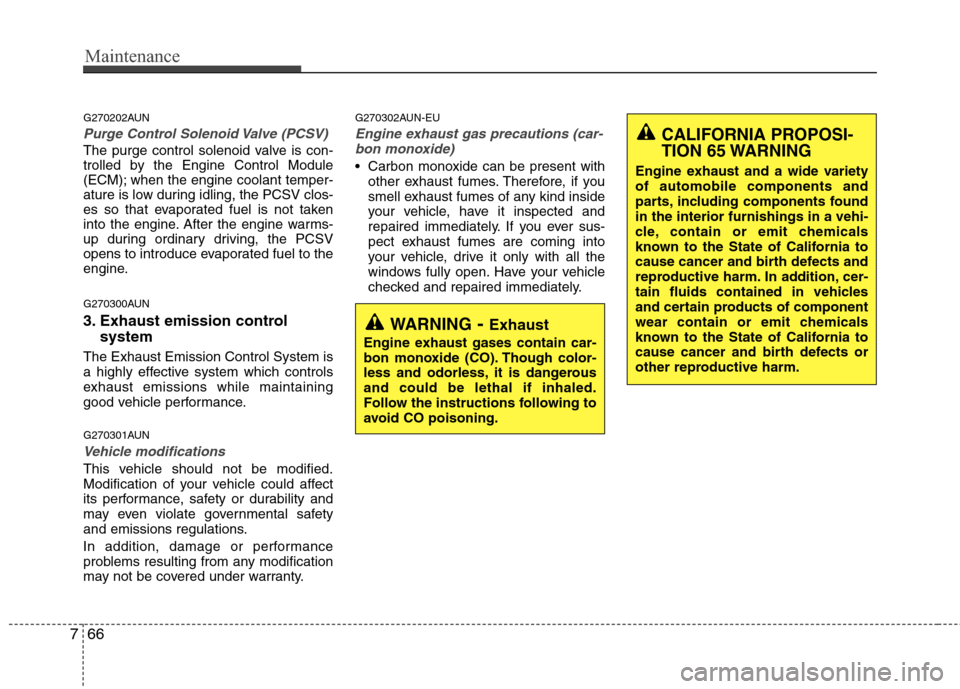
Maintenance
66 7
G270202AUN
Purge Control Solenoid Valve (PCSV)
The purge control solenoid valve is con-
trolled by the Engine Control Module
(ECM); when the engine coolant temper-
ature is low during idling, the PCSV clos-
es so that evaporated fuel is not taken
into the engine. After the engine warms-
up during ordinary driving, the PCSV
opens to introduce evaporated fuel to the
engine.
G270300AUN
3. Exhaust emission control
system
The Exhaust Emission Control System is
a highly effective system which controls
exhaust emissions while maintaining
good vehicle performance.
G270301AUN
Vehicle modifications
This vehicle should not be modified.
Modification of your vehicle could affect
its performance, safety or durability and
may even violate governmental safety
and emissions regulations.
In addition, damage or performance
problems resulting from any modification
may not be covered under warranty.
G270302AUN-EU
Engine exhaust gas precautions (car-
bon monoxide)
Carbon monoxide can be present with
other exhaust fumes. Therefore, if you
smell exhaust fumes of any kind inside
your vehicle, have it inspected and
repaired immediately. If you ever sus-
pect exhaust fumes are coming into
your vehicle, drive it only with all the
windows fully open. Have your vehicle
checked and repaired immediately.
WARNING- Exhaust
Engine exhaust gases contain car-
bon monoxide (CO). Though color-
less and odorless, it is dangerous
and could be lethal if inhaled.
Follow the instructions following to
avoid CO poisoning.
CALIFORNIA PROPOSI-
TION 65 WARNING
Engine exhaust and a wide variety
of automobile components and
parts, including components found
in the interior furnishings in a vehi-
cle, contain or emit chemicals
known to the State of California to
cause cancer and birth defects and
reproductive harm. In addition, cer-
tain fluids contained in vehicles
and certain products of component
wear contain or emit chemicals
known to the State of California to
cause cancer and birth defects or
other reproductive harm.
Page 382 of 402
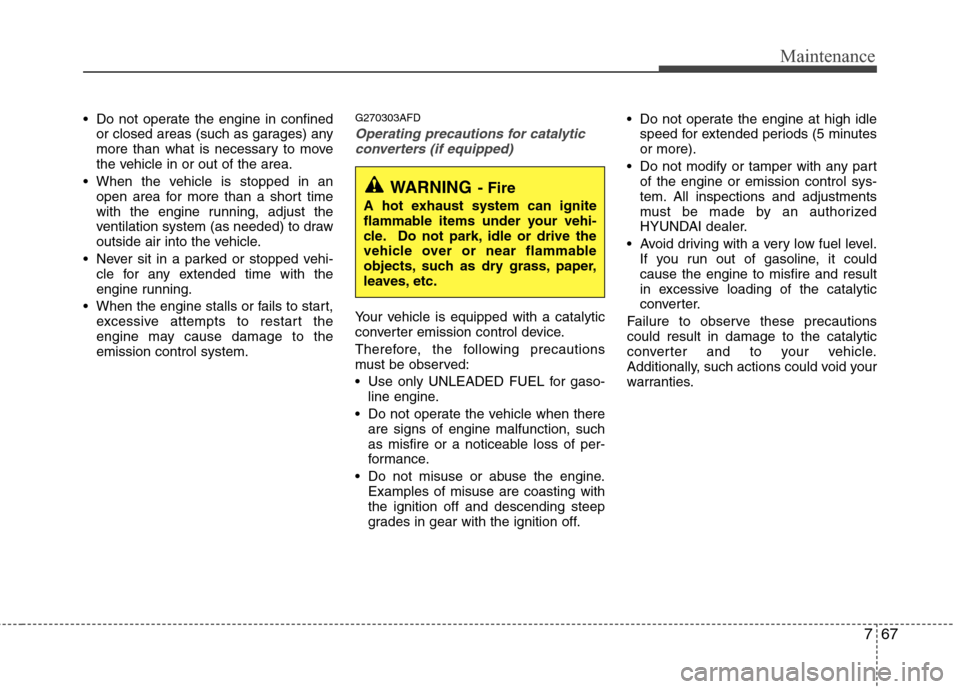
767
Maintenance
Do not operate the engine in confined
or closed areas (such as garages) any
more than what is necessary to move
the vehicle in or out of the area.
When the vehicle is stopped in an
open area for more than a short time
with the engine running, adjust the
ventilation system (as needed) to draw
outside air into the vehicle.
Never sit in a parked or stopped vehi-
cle for any extended time with the
engine running.
When the engine stalls or fails to start,
excessive attempts to restart the
engine may cause damage to the
emission control system.G270303AFD
Operating precautions for catalytic
converters (if equipped)
Your vehicle is equipped with a catalytic
converter emission control device.
Therefore, the following precautions
must be observed:
Use only UNLEADED FUEL for gaso-
line engine.
Do not operate the vehicle when there
are signs of engine malfunction, such
as misfire or a noticeable loss of per-
formance.
Do not misuse or abuse the engine.
Examples of misuse are coasting with
the ignition off and descending steep
grades in gear with the ignition off. Do not operate the engine at high idle
speed for extended periods (5 minutes
or more).
Do not modify or tamper with any part
of the engine or emission control sys-
tem. All inspections and adjustments
must be made by an authorized
HYUNDAI dealer.
Avoid driving with a very low fuel level.
If you run out of gasoline, it could
cause the engine to misfire and result
in excessive loading of the catalytic
converter.
Failure to observe these precautions
could result in damage to the catalytic
converter and to your vehicle.
Additionally, such actions could void your
warranties.
WARNING- Fire
A hot exhaust system can ignite
flammable items under your vehi-
cle. Do not park, idle or drive the
vehicle over or near flammable
objects, such as dry grass, paper,
leaves, etc.
Page 383 of 402
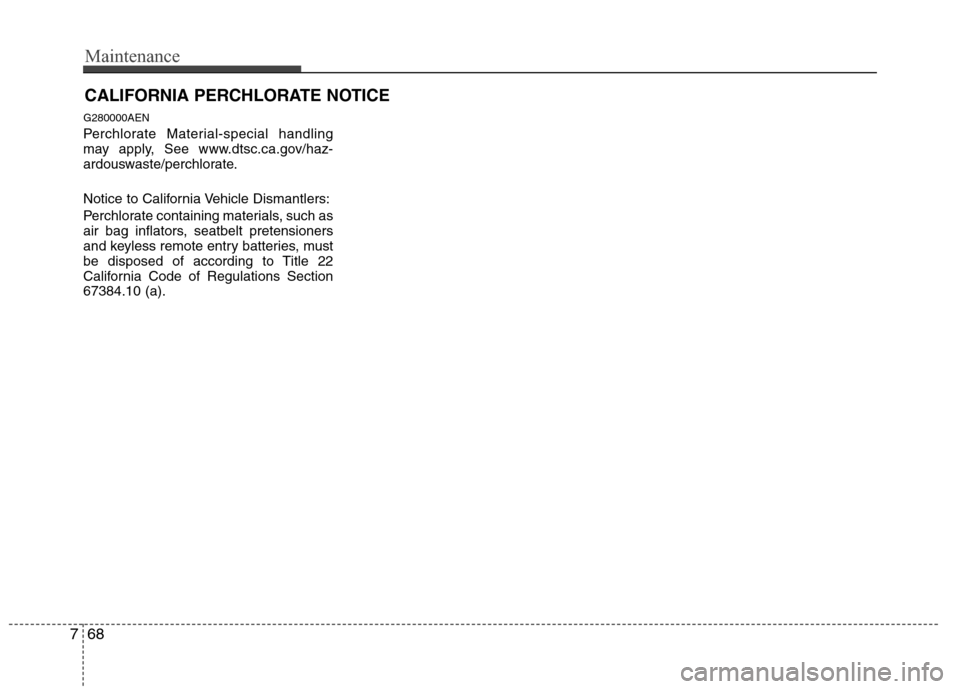
Maintenance
68 7
CALIFORNIA PERCHLORATE NOTICE
G280000AEN
Perchlorate Material-special handling
may apply, See www.dtsc.ca.gov/haz-
ardouswaste/perchlorate.
Notice to California Vehicle Dismantlers:
Perchlorate containing materials, such as
air bag inflators, seatbelt pretensioners
and keyless remote entry batteries, must
be disposed of according to Title 22
California Code of Regulations Section
67384.10 (a).
Page 384 of 402
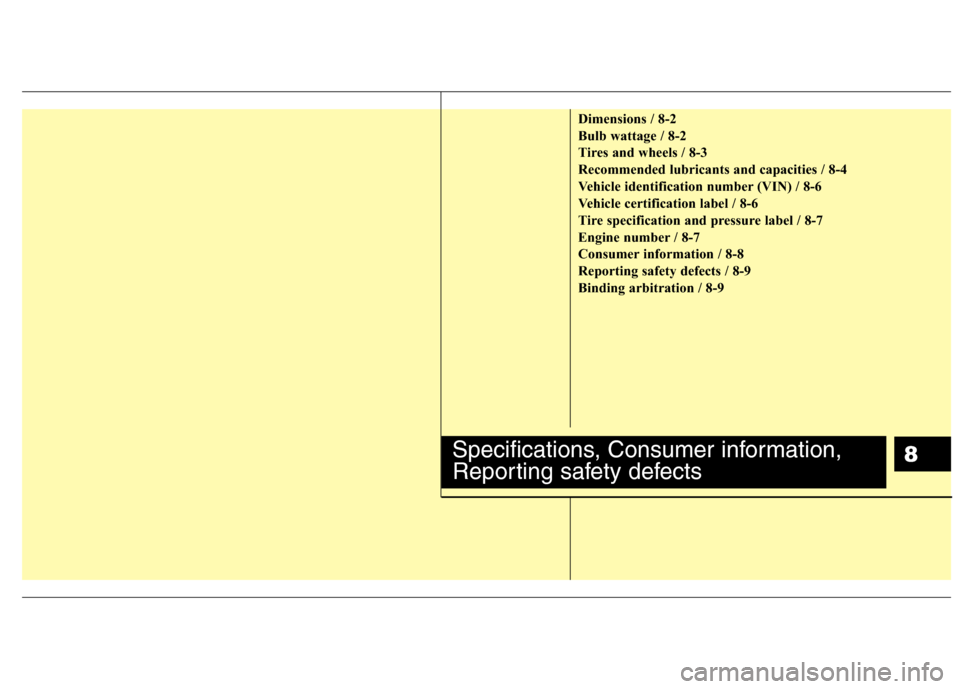
8
Dimensions / 8-2
Bulb wattage / 8-2
Tires and wheels / 8-3
Recommended lubricants and capacities / 8-4
Vehicle identification number (VIN) / 8-6
Vehicle certification label / 8-6
Tire specification and pressure label / 8-7
Engine number / 8-7
Consumer information / 8-8
Reporting safety defects / 8-9
Binding arbitration / 8-9
Specifications, Consumer information,
Reporting safety defects
Page 385 of 402
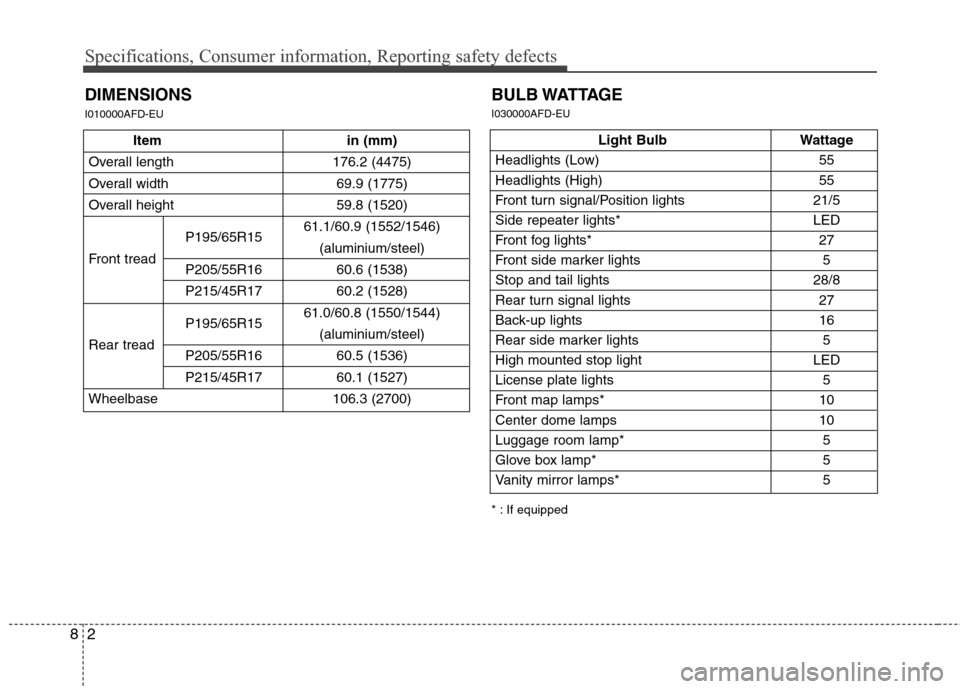
Specifications, Consumer information, Reporting safety defects
2 8
Item in (mm)
Overall length 176.2 (4475)
Overall width 69.9 (1775)
Overall height 59.8 (1520)
61.1/60.9 (1552/1546)
Front treadP195/65R15
(aluminium/steel)
P205/55R16 60.6 (1538)
P215/45R17 60.2 (1528)
61.0/60.8 (1550/1544)
Rear treadP195/65R15
(aluminium/steel)
P205/55R16 60.5 (1536)
P215/45R17 60.1 (1527)
Wheelbase 106.3 (2700)
DIMENSIONS
I010000AFD-EU
Light Bulb Wattage
Headlights (Low) 55
Headlights (High) 55
Front turn signal/Position lights 21/5
Side repeater lights* LED
Front fog lights* 27
Front side marker lights 5
Stop and tail lights 28/8
Rear turn signal lights 27
Back-up lights 16
Rear side marker lights 5
High mounted stop light LED
License plate lights 5
Front map lamps* 10
Center dome lamps 10
Luggage room lamp* 5
Glove box lamp* 5
Vanity mirror lamps* 5
BULB WATTAGE
I030000AFD-EU
* : If equipped
Page 386 of 402

83
Specifications, Consumer information, Reporting safety defects
Inflation pressure
psi (kPa)
Front Rear
P195/65R15 5.5J×15
P205/55R16 6.0J×16 32 (220) 32 (220)
P215/45R17 7.0Jx17
T125/80D15 4.0T×1560 60
(420) (420)
Full size tire
Compact
spare tire *Wheel lug nut torque
lb•ft (kg N
65~79
(9~11, 88~107)
TIRES AND WHEELS
I020000AFD-EU
ItemTire
sizeWheel size
* : If equipped
Page 387 of 402
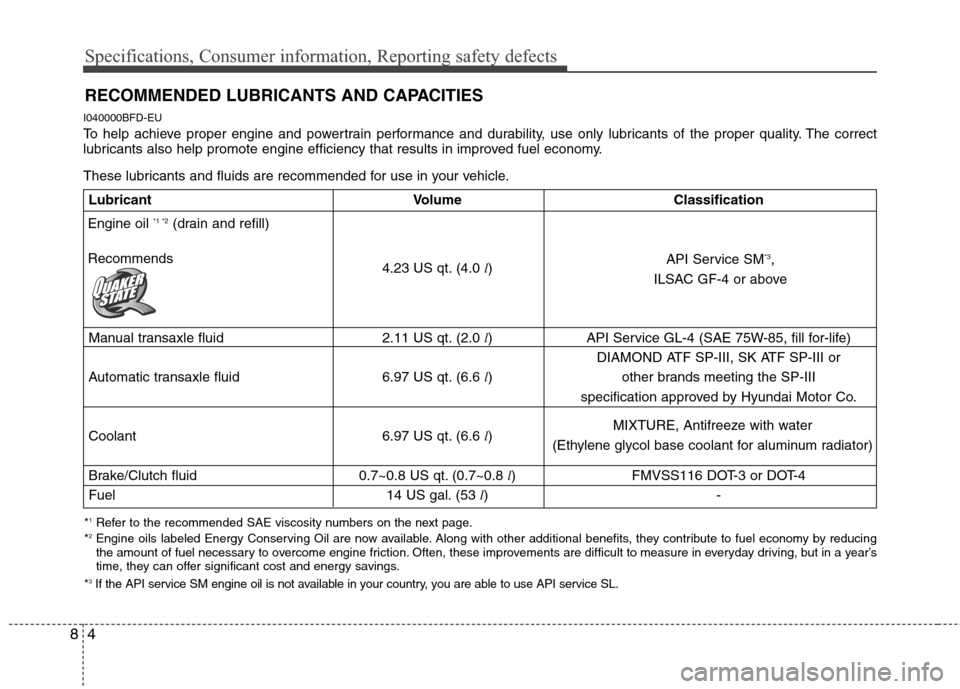
Specifications, Consumer information, Reporting safety defects
4 8
RECOMMENDED LUBRICANTS AND CAPACITIES
I040000BFD-EU
To help achieve proper engine and powertrain performance and durability, use only lubricants of the proper quality. The correct
lubricants also help promote engine efficiency that results in improved fuel economy.
These lubricants and fluids are recommended for use in your vehicle.
*1Refer to the recommended SAE viscosity numbers on the next page.
*2Engine oils labeled Energy Conserving Oil are now available. Along with other additional benefits, they contribute to fuel economy by reducing
the amount of fuel necessary to overcome engine friction. Often, these improvements are difficult to measure in everyday driving, but in a year’s
time, they can offer significant cost and energy savings.
*
3If the API service SM engine oil is not available in your country, you are able to use API service SL.
Lubricant Volume Classification
4.23 US qt. (4.0 l)
Manual transaxle fluid 2.11 US qt. (2.0 l) API Service GL-4 (SAE 75W-85, fill for-life)
DIAMOND ATF SP-III, SK ATF SP-III or
Automatic transaxle fluid 6.97 US qt. (6.6 l) other brands meeting the SP-III
specification approved by Hyundai Motor Co.
Coolant 6.97 US qt. (6.6 l)
Brake/Clutch fluid 0.7~0.8 US qt. (0.7~0.8 l) FMVSS116 DOT-3 or DOT-4
Fuel 14 US gal. (53 l)-
Engine oil *1 *2(drain and refill)
Recommends
API Service SM
*3,
ILSAC GF-4 or above
MIXTURE, Antifreeze with water
(Ethylene glycol base coolant for aluminum radiator)
Page 388 of 402
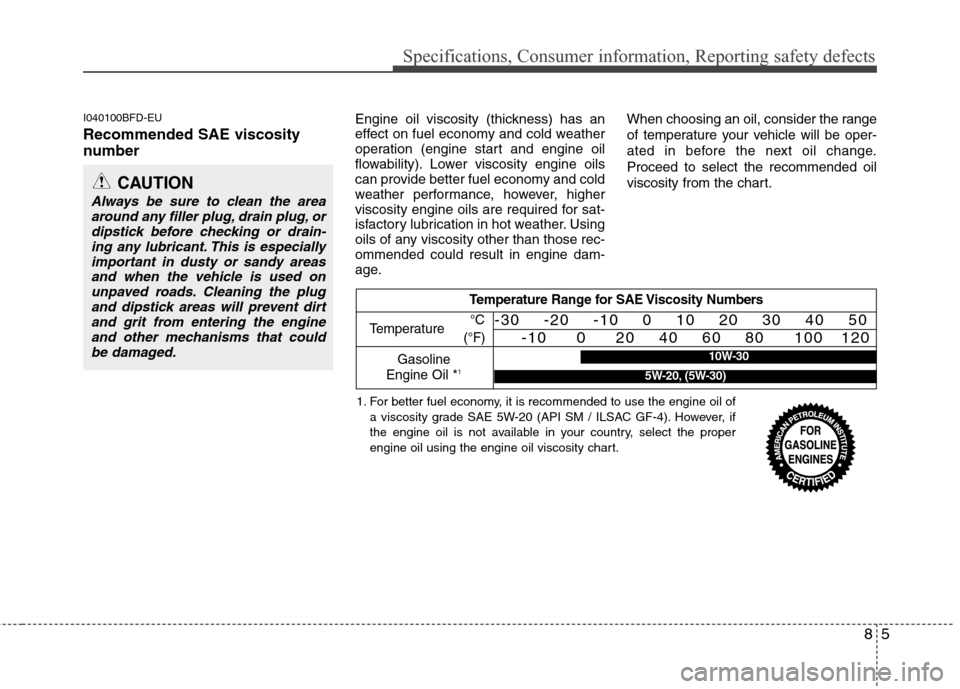
85
Specifications, Consumer information, Reporting safety defects
I040100BFD-EU
Recommended SAE viscosity
number
Engine oil viscosity (thickness) has an
effect on fuel economy and cold weather
operation (engine start and engine oil
flowability). Lower viscosity engine oils
can provide better fuel economy and cold
weather performance, however, higher
viscosity engine oils are required for sat-
isfactory lubrication in hot weather. Using
oils of any viscosity other than those rec-
ommended could result in engine dam-
age.When choosing an oil, consider the range
of temperature your vehicle will be oper-
ated in before the next oil change.
Proceed to select the recommended oil
viscosity from the chart.
CAUTION
Always be sure to clean the area
around any filler plug, drain plug, or
dipstick before checking or drain-
ing any lubricant. This is especially
important in dusty or sandy areas
and when the vehicle is used on
unpaved roads. Cleaning the plug
and dipstick areas will prevent dirt
and grit from entering the engine
and other mechanisms that could
be damaged.
Temperature Range for SAE Viscosity Numbers
Temperature
Gasoline
Engine Oil *
1
°C
(°F)-30 -20 -10 0 10 20 30 40 50
-10 0 20 40 60 80 100 120
10W-30
5W-20, (5W-30)
1. For better fuel economy, it is recommended to use the engine oil of
a viscosity grade SAE 5W-20 (API SM / ILSAC GF-4). However, if
the engine oil is not available in your country, select the proper
engine oil using the engine oil viscosity chart.
Page 389 of 402

Specifications, Consumer information, Reporting safety defects
6 8
VEHICLE IDENTIFICATION
NUMBER (VIN)
H010000AFD
The vehicle identification number (VIN) is
the number used in registering your car
and in all legal matters pertaining to its
ownership, etc.The number is punched on floor under
the passenger seat. To check the num-
ber, remove the cover.(Type A)
The VIN is also on a plate attached to the
top of the dashboard. The number on the
plate can easily be seen through the
windshield from outside.(Type B)
VEHICLE CERTIFICATION
LABEL
H020000AUN
The vehicle certification label attached
on the driver’s side center pillar gives the
vehicle identification number (VIN).
OHD086007
OHD086001
OFD087002
Type A
Type B
Page 390 of 402
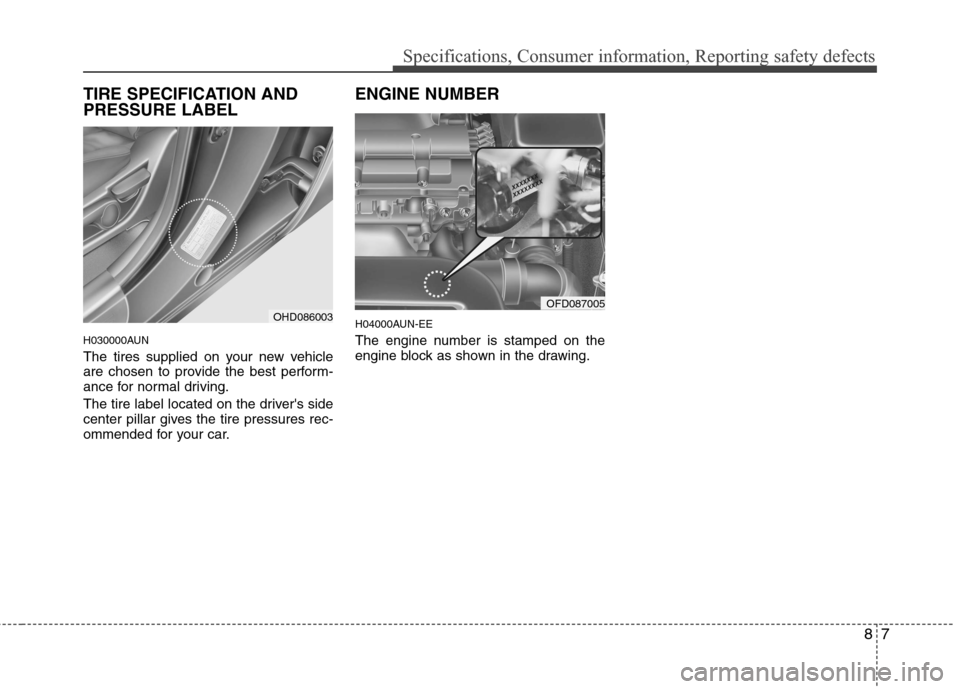
87
Specifications, Consumer information, Reporting safety defects
TIRE SPECIFICATION AND
PRESSURE LABEL
H030000AUN
The tires supplied on your new vehicle
are chosen to provide the best perform-
ance for normal driving.
The tire label located on the driver's side
center pillar gives the tire pressures rec-
ommended for your car.
ENGINE NUMBER
H04000AUN-EE
The engine number is stamped on the
engine block as shown in the drawing.
OFD087005OHD086003